Why You Should Use Web Push To Reach Your Email Marketing Haters
 What if I said we've been blowing smoke when we talked about email marketing on this blog?
We've devoted a fair amount of space talking about email marketing—many thousands and thousands of words, in fact.
First, we've convinced you that a substantial effort has to go toward building the number of emails on your list. Then, we've told you about the best ways to get people to sign up, and how to get people to open your email.
But what if email was on the road to inevitable failure? What if there was something coming that would make it obsolete?
Think of all the effort you've put into your email list. It's terrifying to consider that it might be the marketing version of the VHS tape, but perhaps that is inevitable thanks to Web push.
What if I said we've been blowing smoke when we talked about email marketing on this blog?
We've devoted a fair amount of space talking about email marketing—many thousands and thousands of words, in fact.
First, we've convinced you that a substantial effort has to go toward building the number of emails on your list. Then, we've told you about the best ways to get people to sign up, and how to get people to open your email.
But what if email was on the road to inevitable failure? What if there was something coming that would make it obsolete?
Think of all the effort you've put into your email list. It's terrifying to consider that it might be the marketing version of the VHS tape, but perhaps that is inevitable thanks to Web push.
Why You Should Use #WebPush To Reach Your #EmailMarketing Haters via @JulieNeidlinger
Click To TweetWhat Is Web Push?
You are already familiar with Web push if you are using an Internet browser like Safari (Chrome and Firefox have indicated they'll be getting Web push soon), and get notifications for things such as new Twitter activity. In a way, Web push is sort of like the notifications you get on your smartphone, except that Web push happens through your computer's Internet browser, where most of us spend our workday. Any of your readers who have allowed your notifications to appear in their browser will receive a notification the next time you publish new content. They can click on the notification and be taken to your freshly published content easily. Web push is attractive to your readers for several reasons.1. Web push is easy to use.
Web push is simple for your readers to set up. When readers arrive at your Web push-enabled website, a notification pops up asking if they'd like to be notified every time you publish new content. Unlike email or other calls-to-action, Web push is painless. The user can easily select "Allow" or "Don't Allow" when asked if they want notifications, and the window goes away.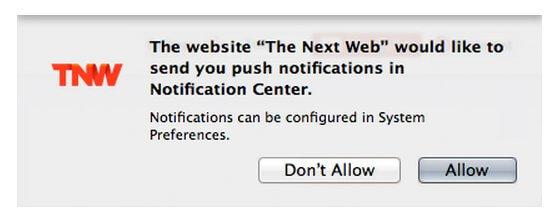 That's it.
They can go on with their Internet browsing without having to verify email later or go to a sign-up page. The barrier to entry is very low—you can't get much easier than one click, which is all that Web push requires of your reader.
That's it.
They can go on with their Internet browsing without having to verify email later or go to a sign-up page. The barrier to entry is very low—you can't get much easier than one click, which is all that Web push requires of your reader.
2. The permission window is familiar.
The Web push window that pops up asking if your reader would like to be notified looks like any other browser-based permission window. That's easier to trust than a custom marketing pop-up window.Why You Should Be Using Web Push
Not every content marketing tool that comes along is worth your time, but Web push is something you should consider using. It very directly gets your content in front of eyeballs that are receptive to it, making it similar to email in that readers have opted in.It's easy to get started.
You can get your site ready for Web push without having to be a developer. Using Roost, you can set up Web push on your site easily with several integrations, including a WordPress plugin that makes managing Web push from your WordPress dashboard possible.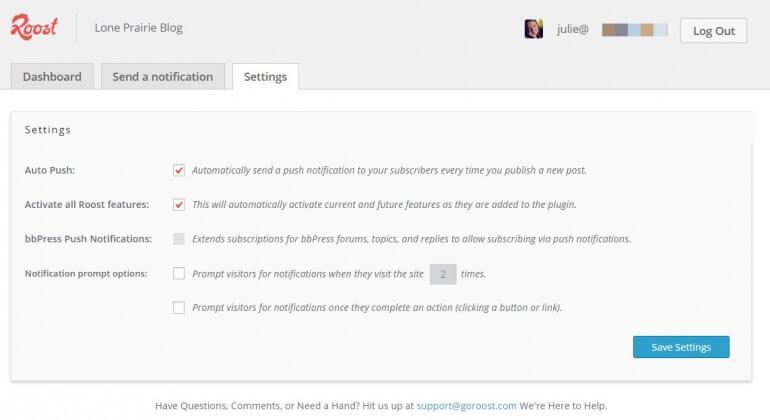 Roost makes setting up Web push in your WordPress blog easy.
With Roost, your notifications can be automatically generated whenever you publish new content, or you can create custom notifications and send them manually to all of your subscribers.
Roost makes setting up Web push in your WordPress blog easy.
With Roost, your notifications can be automatically generated whenever you publish new content, or you can create custom notifications and send them manually to all of your subscribers.
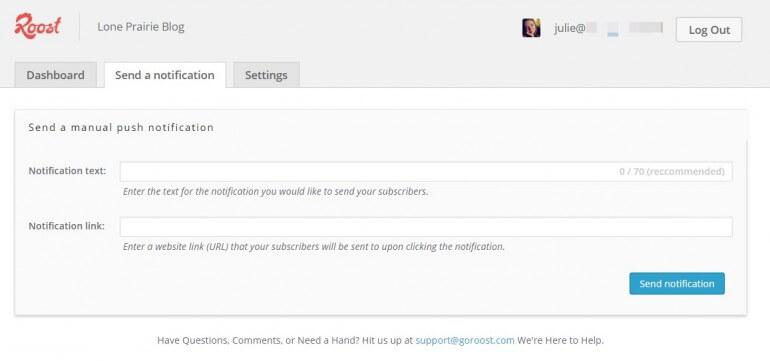 Taking the idea of push notifications a step further, you could also use Pushbullet to get notifications right where your readers are. Pushbullet is a mobile app (not limited to just a browser) that also has browser extensions to make push available for non-Safari users.
While Pushbullet has features directed at individual user convenience (text messaging, link sharing between devices, phone notifications to your desktop), they also allow users to subscribe to channels. That's where content marketers might want to take notice.
By setting up a Pushbullet channel that uses your RSS feed, you can notify subscribers of new content immediately, much the same as Safari users experience Web push. It appears on their mobile phone, and on their desktop.
Taking the idea of push notifications a step further, you could also use Pushbullet to get notifications right where your readers are. Pushbullet is a mobile app (not limited to just a browser) that also has browser extensions to make push available for non-Safari users.
While Pushbullet has features directed at individual user convenience (text messaging, link sharing between devices, phone notifications to your desktop), they also allow users to subscribe to channels. That's where content marketers might want to take notice.
By setting up a Pushbullet channel that uses your RSS feed, you can notify subscribers of new content immediately, much the same as Safari users experience Web push. It appears on their mobile phone, and on their desktop.
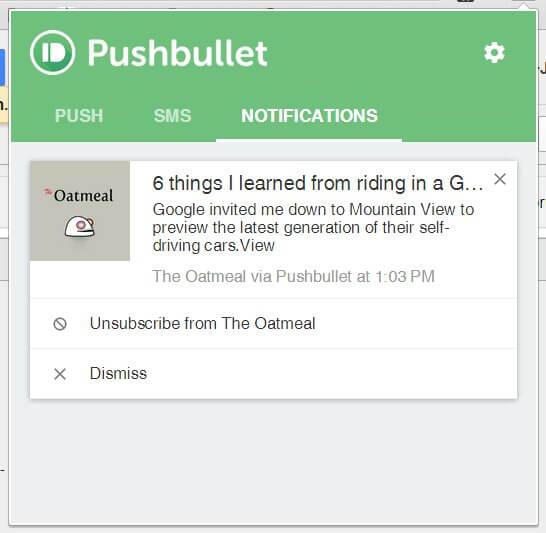
Web push happens where your audience is.
One of the big challenges content marketers face is choosing which social networks they will publish content on. There are so many networks, and each network attracts a different kind of user. Content marketers often struggle with managing all of these publishing channels. With Web push, it doesn't matter what social networks your reader prefers, because it has nothing to do with them. Instead, it is independent of social networks, appearing right in their browser. You don't have to create different, customized messages optimized for different networks. You don't have to research which kind of networks your niche performs best on. Just like with the email you send, your content arrives where your audience is already working, outside of a network.Web push helps build data for you.
When we measure the success of a blog post or headline, we often deal with a variety of metrics. Traffic, perhaps, and how many social shares it received. Web push gives you another avenue of metrics, allowing you to A/B test everything from the best time to send notifications to what kind of messages might lead to unsubscribing. For those of you who like to A/B test and base content marketing decisions on hard data, Web push is another building block for you, a chance to learn about your audience's behavior outside of social networks and search engines.Try #WebPush to A/B test #headlines and understand the best times to publish your #blog posts.
Click To TweetWeb push gives you control and customization.
Despite the simplicity of Web push, both for the end user and for you to set up, you still have some customizations and control available to you. Roost recently announced that you can now send specific blog post categories to different subscriber segments, allowing your readers to see only what they want to see. If you're a heavy blogger and publish several posts a day, you might send out a notification to a summary email or link instead of a notification for every blog post. You can send out important product updates, or breaking news. With the simple system of Web push, you can control what gets sent to whom. It is more than just an RSS feed on notification steroids.Web push opens a door for people who don't like email marketing.
Not everyone likes getting marketing emails, and Web push helps solve that problem. You're probably pretty invested in your email marketing, accepting the loss of those folks you know don't want your marketing email in their inbox. According to blogger Tim Varner, Web push has an opt-in rate that is 10 times higher than email newsletters.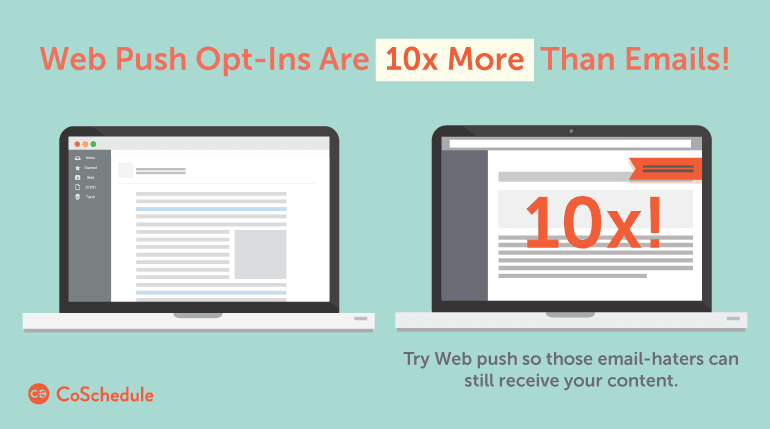 I'll admit I've become both worn out and disinclined to hand out my email address as freely as I once did.
Web push allows me to stay connected to a blog I like but keep my email to myself. I can also control what kind of notifications I'll receive, and I like that I have control.
Web push is the perfect patch for the anti-marketing streak that runs through some of your audience.
I'll admit I've become both worn out and disinclined to hand out my email address as freely as I once did.
Web push allows me to stay connected to a blog I like but keep my email to myself. I can also control what kind of notifications I'll receive, and I like that I have control.
Web push is the perfect patch for the anti-marketing streak that runs through some of your audience.
#WebPush is the perfect way to reach your #EmailMarketing haters.
Click To TweetWhy Email Is Still The King
Web push sounds pretty great, doesn't it? But rest assured that all of the attention we've given to growing your email list hasn't been misplaced. We haven't led you astray. We were not blowing smoke.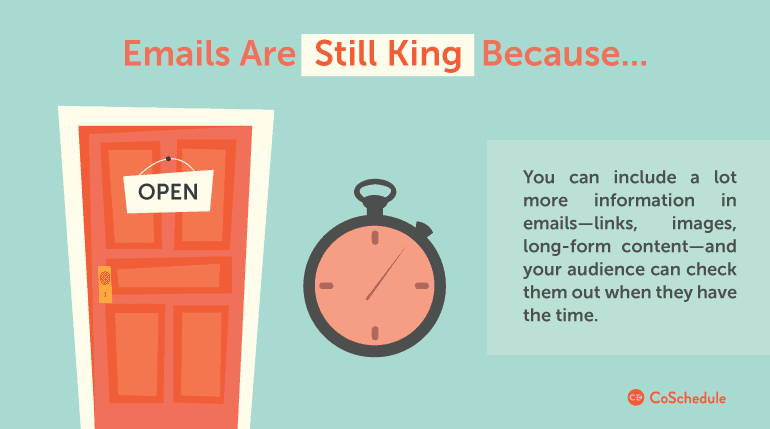 The truth is, Web push will not replace email. It's cool, it has promise, and it's yet another great tool for your content marketing tool box, but...it isn't as powerful as email.
The truth is, Web push will not replace email. It's cool, it has promise, and it's yet another great tool for your content marketing tool box, but...it isn't as powerful as email.
Web push is easy to abuse.
It's so easy to send notifications to your subscribers that you might be tempted to do it more often than you should. Notifications aren't the same as an email. An email shows up in the inbox and sits there until your reader decides to do something with it. A notification does not give the reader that kind of control, and a simple one-click unsubscribe is likely to happen if the notifications annoy your reader in that moment. Just as Web push notifications are easy to allow, it's easy to turn off, too. The temptation and simplicity of sending out many notifications may prove too much for some marketers.Web push does not get an email address.
Attracting audience members who don't want to give you an email address is a catch 22. Web push doesn't give you anything from your audience, beyond the permission of sending notifications and the data from their usage.Here's why #WebPush won't change your #EmailMarketing via @JulieNeidlinger
Click To TweetNotifications are short-lived.
The Web push notifications that appear in your reader's browser are short lived. They don't sit there forever. They appear long enough to be noticed and read before disappearing.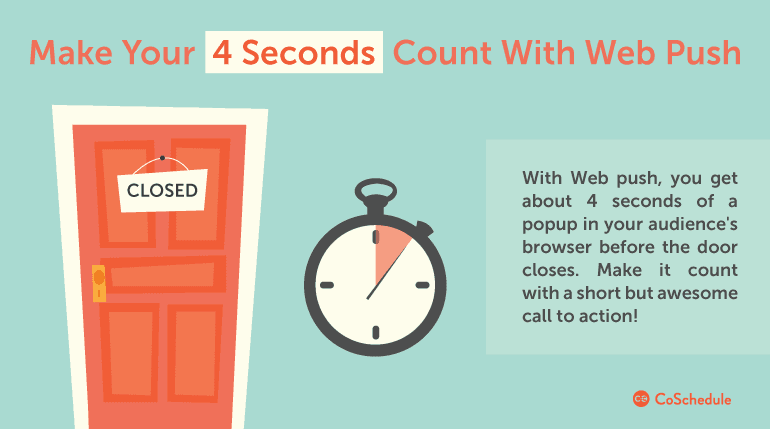 Some users may visit their notifications tray to sort through notifications, but let's be honest: Few of us do that. If the reader steps away from their computer when the notification comes through, they'll miss it.
An email, on the other hand, sits in the inbox until the reader is ready to read.
Some users may visit their notifications tray to sort through notifications, but let's be honest: Few of us do that. If the reader steps away from their computer when the notification comes through, they'll miss it.
An email, on the other hand, sits in the inbox until the reader is ready to read.
Web push has Twitter-like content limitations.
You can't send your readers a book using Web push. Just like Twitter limits you to 140 characters, Web push has its own limitations. Your headlines and content snippets will have a huge role to play in whether or not you'll get someone to click through to your blog.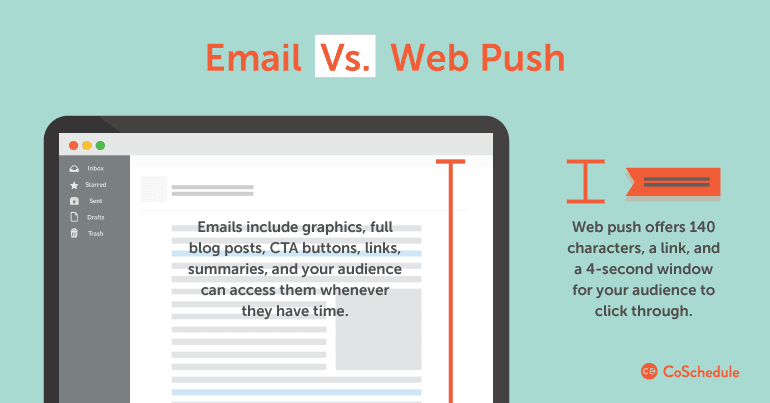 An email, on the other hand, gives you a lot more leeway when it comes to the amount of content you deliver to the inbox. Graphics, full blog posts, CTA buttons, links, and summaries are possible with email, but certainly not with Web push.
An email, on the other hand, gives you a lot more leeway when it comes to the amount of content you deliver to the inbox. Graphics, full blog posts, CTA buttons, links, and summaries are possible with email, but certainly not with Web push.


